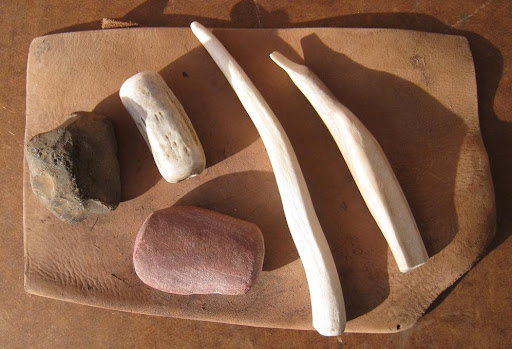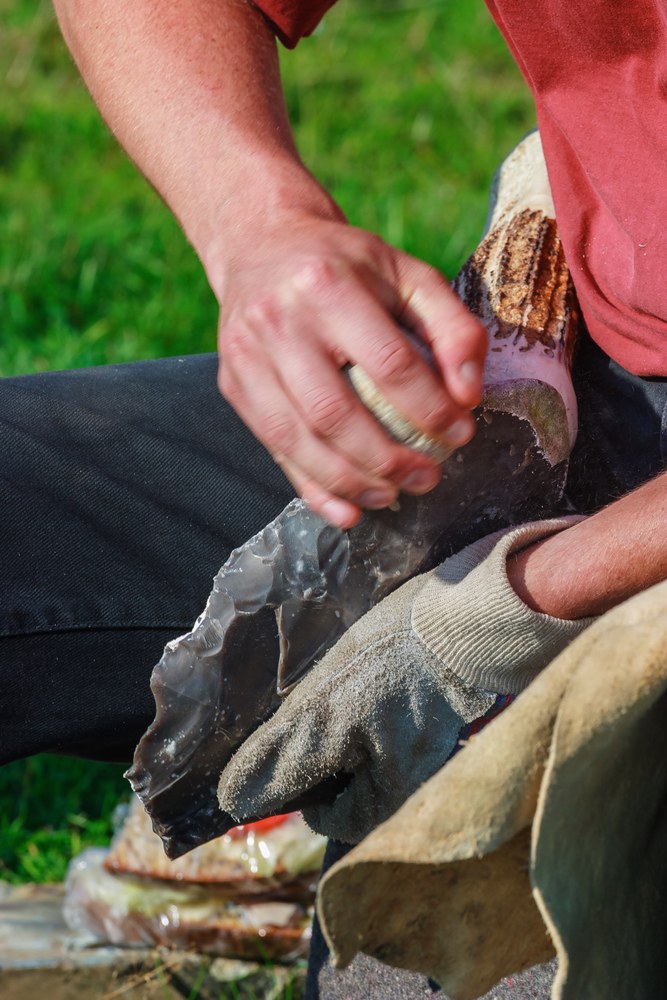Last Updated on November 11, 2022 by admin_hunter
Flint knapping turns stone, preferably flint, into tools for cutting and stabbing. It is an ancient technique that still has its place in modern survival situations. It is also an interesting skill many people use to make everything from stone knives for decorative purposes to traditional arrowheads to keep the past alive.
Using flint knapping tools to craft stone into various objects can be useful if you find yourself lost in the wilderness, but it can also be a rewarding hobby. To teach you how to make your own flint knapping tools, we encourage you to read through our straightforward, step-by-step guide!
What Will You Need to Make Flint Knapping Tools?
Before we get started with our instructions, make sure you have the following pieces of equipment on hand:
- A thick sheet of canvas or leather
- Sharp scissors for cutting your leather or canvas sheet
- A large 1-inch to 2-inch wide piece of animal bone or antler
- A smaller 1/4-inch to 2/3-inch wide cylindrical piece of animal bone or antler
- A hacksaw
- A sharp hunting knife (if you do not own a knife, we recommend reading our Best Survival Knives for 2022 Guide)
- A rounded, flat stone that is roughly the size of the palm of your hand
While you should be able to find these tools reasonably easily, you also have the option to visit Flint Knapping Supplies LLC, which offers a wide collection of high-quality, ready-made flint knapping tools. They offer everything from traditional tools to modern-day, beginner-friendly options.
Step-by-Step Guide for Making Flint Knapping Tools

Once you have everything that you will need, you can proceed through the following steps:
1. Shape Your Canvas or Leather Pads
Take your thick sheet of canvas or leather and cut it with your sharp scissors into two pieces. These pieces will act as your work pads.
The first piece should be rectangular and large enough to cover your lap. The other piece will be much smaller, as it only needs to be slightly bigger than the palm of your hand. While the first, larger piece will protect your legs, the smaller piece only has to pad your hand from the force of the striking stone.
2. Prepare and Cut Your Animal Bones or Antlers
Take your chosen pieces of animal bone or antlers. They should be clean and dry. After you prep them, take your hacksaw and cut the top off either piece, so they have a level surface.
These two pieces will act as large and small chisels for major shaping tasks and finer detail work.
You can now take your knife and use it for whittling a chisel edge on the bottom of your two pieces of bone or antler. Try to envision a typical metal chisel and shape the end of your bone or antler to have that same shape.
3. Find an Appropriate Hammer Stone
If you have not already done so, you should find your palm-sized, rounded stone. It will act as your striker, or hammer. You do not want it to be too big and heavy, or it will be challenging to work with. Ideally, it will be almost the exact size of the palm of your hand.
You also want to ensure that you are not using a hammer stone with sharp or uneven edges, as this will only end up hurting your hand as you work.
Make sure that the stone you have chosen for your percussion tool is durable, or else it will wear away as you work. For this reason, avoid sandstone. Instead, favor a more solid igneous rock.
Congratulations, you have now made your own flint knapping tools from traditional materials!
More Information About Making Flint Knapping Tools
If you still have questions about making flint knapping tools or want to see a video of the process, we recommend checking out MC Art and Tool’s informative YouTube video – How to Make Flint Knapping Tools.
This video guide walks you through the process and demonstrates how you can use your newly created stone tools to make your own flint arrowheads.
What Is Flint?
Now that you know how to make the tools needed to work with flint, we can explain what flint actually is and what it is used for.
Flint is a sedimentary rock known to crack in ways that leave an incredibly sharp edge. Thanks to this unique quality, flint has been used for thousands upon thousands of years to make all sorts of hunting and cooking tools and weapons for self-defense. People even use it to start fires.
While this primitive technology was critical for survival during the Stone Age and in numerous cultures worldwide for thousands of years after this period, it still has its uses in the modern day. If, for example, you found yourself lost in the woods with next to no supplies, being able to craft essential flint tools, like a hunting spearhead, could keep you alive.
What Is Flint Knapping?
As mentioned above, your flint knapping technique is the controlled shaping of flint stones to create anything from a flint arrowhead to a stone knife blade.
Archaeologists have found evidence of flint knapping in ancient societies all over the world. While we often think of it as being a Stone Age technique, flint and flint knapping were used regularly in far more recent times.
The knapping of gun flints took place regularly with the emergence of the first flintlock firearms.
Can Flint Be Used for Starting Fires?

Another popular use of flint is its ability to be used in a fire-starting capacity. When flint is struck rapidly against steel, it can generate sparks.
Skilled survivalists can quickly start a full-sized campfire by using a small piece of flint, a collection of flammable tinder, and a small steel striker. As you can imagine, this is incredibly useful in survival situations.
Knowing that you could start a fire with a steel hunting knife and a small piece of flint should be reason enough to carry a magnesium flint stone fire starter with you on camping and hunting trips! We actually cover this in our explanation of How to Survive in the Wilderness with Just a Knife.
We recommend reading How to Start a Fire with Wet Wood for more fire-related survival tips.

